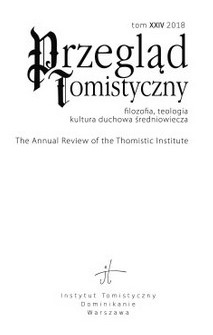MICHAŁ MROZEK OP, Aristotle’s Categories in the Summa of Theology of St. Thomas Aquinas

Tom XXIV: 2018
Filozofia — Teologia— Kultura duchowa średniowiecza
ISSN 0860-0015
e-ISSN 2544-1000
SUMMARY
Aristotelian Categories is one of the fundamental philosophical texts and it is particularly interesting how St. Thomas Aquinas perceives and integrates this work into his theological way of thinking. Thomistic literature addresses this issue in two ways: either in detailed philosophical approaches (for example in the context of questions concerned with the Latin term habitus) or as a background to philosophical or theological syntheses. However, it is not easy to combine these perspectives. This article may facilitate this by tracing how Aquinas quotes Categories within his greatest synthesis — the Summa Theologica.
The Categories consists of three parts: a general introduction (the antepraedicamenta), discussion of individual categories, and the postpraedicamenta. Aquinas discusses the entire list and the order of categories in two classical places: in the Commentary on Physics and in the Commentary on Metaphysics. These places allow us to see Aquinas’s synthetic approach to the list of the ten categories.
Aquinas quotes the Categories quite frequently. Using the index of the Leonine editions, as well as the Index Thomisticus search engine, it was possible to identify a complete list of Aquinas’s direct references to this work, supplemented with all the places where the word praedicamentum appears. It gives 68 places in Aquinas’s Summa Theologica. Most of these references can be presented in the sequence of the Stagirite’s considerations, which gives an advantage in the form of a cross-sectional summary of how they appear in the synthesis of Aquinas. The rest of those references play a more modest role of bibliographical links to the commentary tradition, mainly of Simplicius and Boethius.
Tracking these references allows for various observations and conclusions. An example of this is that the category of relation (ad aliquid) appears in Aquinas’s considerations of the Holy Trinity whereas the category of quantity (quantitas) first of all in Aquinas’s consideration of the sacraments, i.e. in reference to the body of Christ present in the sacrament of the Eucharist.
In general, such references appear usually in the context of objections. However, in none of these places, even the most theological ones, does Thomas deny the logic contained in the categories, and never undermines them in the name of apophatic predication or in relation to divine omnipotence. In extreme cases, Aquinas shows at least that there is no contradiction, for example when considering the category substance and category ad aliquid in relation to God. Aquinas underlines that the categories are insufficient in this case and explains why this is so.
ometimes, however, the elaboration of Aristotelian categories constitutes the foundation of theological considerations, like when Aquinas elaborates the term habitus. Aquinas reports questions and problems related to this concept due to its ambiguity and various attempts to solve them, including that of Simplicius. By means of the presentation of an accurate account of the status quo of those problems, Aquinas makes his own refinements and solutions. Thus, the habitus understood as the first species of quality becomes a reference point for the definition of the virtues and the gifts of the Holy Spirit as their genus proximus. Philosophical settlements at the category level allow us to understand the connection of moral theology with anthropological considerations, and thus helps us to see better the key assumptions that unify the structure of the Summa Theologica into a coherent whole.
